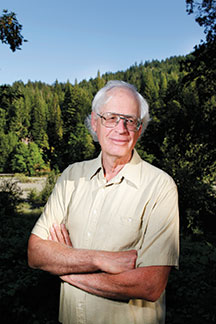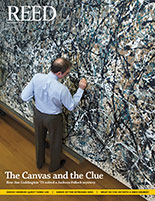
IRIS login | Reed College home Volume 92, No. 3: September 2013
The Mythbuster
Historian Ray Raphael ’65, MAT ’68, searches for the truth about America’s founding era.
By Miles Bryan ’13
The first thing you notice about Ray Raphael is his energy. When he’s making a point—which is most of the time—his body vibrates like the skin of a drum, while his shock of white hair bounces up and down in counterrhythm. Past retirement age, he exudes a healthy glow—acquired in part by kayaking on the Eel River, which runs by his home in the northern California town of Redway. He perches on a stool in his jumbled kitchen nook, a mug of coffee within easy reach.
The energy isn’t wasted. Ray is the author of 18 books, ranging from young adult fiction to a survey of the marijuana industry. But his central focus is the American Revolution—he’s written no fewer than eight books on the subject, including Constitutional Myths: What We Get Wrong and How to Get It Right, and he’s got two more on the way.
Calling the American Revolution well-trodden ground is a masterpiece of understatement. A quick library search yields over 75,000 books on the subject. Some 2,498 books were published last year alone—roughly one title every four hours. So what drives him to keep writing, day after day, page after page? The answer is simple. Ray wants to rescue history from mythology. He wants our understanding of revolutionary America to be based on evidence, not ideological convenience. And he won’t stop until he gets it right.
![]()
Ray came to Reed in 1961 to escape the brick walls and narrow streets of New York City. His freshman housing was auspicious—his Coleman dormmates included the brilliant game-show prodigy Lenny Ross ’63 and Peter Norton ’65 of Norton AntiVirus fame. Initially planning to major in mathematics, Ray gravitated towards the humanities, inspired largely by the Hum 110 conference of Roger Porter [English 1961–]. He remembers the debates in class as egalitarian and open, with one important provision: Porter required his students to heed the historical documents at hand when making an argument. It was Porter, Ray says, who taught him the critical importance of separating opinion and dogma from what could be known with the available evidence—and of pursuing the latter.
In 1962 Ray traveled to North Carolina to register African Americans to vote. In 1964 he joined the Student Nonviolent Coordinating Committee in Mississippi’s Freedom Summer. Inspired by these experiences, Ray spent much of his Reed tenure as an activist, first in civil rights and later against the Vietnam War. In 1965, when the nuclear scientist Herman Kahn (infamously satirized in Dr. Strangelove) was invited to speak at commencement, Ray boycotted the ceremony and ate hot dogs in the canyon.
If the anti–Vietnam War movement of the 1960s was in part about protesting the nihilistic rationality of figures like Kahn, Constitutional Myths addresses the irrationality of a new force in American politics: the Tea Party. Each of the book’s eight chapters addresses a common misperception about the Constitution, looks at how the idea gained currency, and concludes with a fuller, more detailed account. In the chapter on taxes, for example, he tackles the myth that “the framers hated taxes” (substantiated by a quote by Rep. Michele Bachmann of Minnesota). He begins with a “kernel of truth” tracing the origins of the myth. The founders, Ray explains, did fear that granting the central government power to tax might reproduce the injustices inflicted on the colonies by the British Crown. With that acknowledgement, he lays out “the full story”—the historical progression that led to the framing of the Constitution—which is usually at odds with the Tea Party interpretations. Regarding taxation, Ray notes that the power of the U.S. Congress to levy taxes was central to the framers’ thought. In fact, the crisis created by the inability of the Continental Congress to levy tax under the Articles of Confederation was one of the main reasons that the framers went back to the drawing board in 1787.
Ray returned to Reed in 1968 to get a master’s in teaching. Afterwards he followed the burgeoning back-to-the-land movement to northern California, where he taught every subject (except foreign languages) in the tiny high school in Whale Gulch, located in the wilds of Mendocino County. In the 1970s, Ray taught at College of the Redwoods, a community college in Humboldt County, and in the 1990s he started working with Humboldt State University in history education.
At the heart of Ray’s work lies a qualitative distinction between “history” and “heritage.” History is what can be known about a subject through the available contemporaneous accounts and documents, an understanding of how an event—a war, a revolution—was experienced through the eyes of those who lived through it. “Heritage,” by contrast, is the received wisdom that accumulates on key events or figures over time. Constitutional Myths is ultimately an exercise in distinguishing one from the other, in stripping the chaff of heritage away from history. As he writes in the introduction:
“The past is a foreign country,” people say. Although we all might agree with that statement on some level, this particular past—the framing and ratification of our Constitution—is our country too. Because it lives with us today and even determines our actions, it clouds the distinctions between past and present and tempts us to forget the most fundamental of all historical truths: that was then and this is now.
To be sure, heritage has its place. Uplifting stories about our shared revolutionary past can bring the most bitterly divided Americans together. But while those myths make great bedtime stories, they become dangerous when our elected officials take them as fact. The framers believed that unfettered debate was the cornerstone of their fledgling republic—that pugnacious writers like Ray were essential to stop the nation from becoming brittle. Ray’s got his work cut out for him. His mug of coffee is empty. He pours another.
Selected Raphael
Constitutional Myths: What We Get Wrong and How to Get It Right
The New Press, 2013
Mr. President: How and Why the Founders Created a Chief Executive
Knopf, 2012
Revolutionary Founders: Rebels, Radicals, and Reformers in the Making of the Nation (Coedited) Knopf, 2011
The Complete Idiot’s Guide to the Founding Fathers and the Birth of Our Nation Penguin, 2011
Founders: The People Who Brought You a Nation The New Press, 2009
Founding Myths: Stories that Hide Our Patriotic Past The New Press, 2004
The First American Revolution: Before Lexington and Concord The New Press, 2002
A People’s History of the American Revolution: How Common People Shaped the Fight for Independence The New Press, 2001
Two Peoples, One Place: Humboldt History, Vol 1 Humboldt County Historical Society, 2007, 2011
An Everyday History of Somewhere Knopf, 1974
Edges: Human Ecology of the Backcountry Knopf, 1976
Cash Crop: An American Dream Ridge-Times Press, 1985
Tree Talk: The People and Politics of Timber Island Press, 1981
More Tree Talk: The People, Politics, and Economics of Timber Island Press, 1994
Little White Father: Redick McKee on the California Frontier Humboldt County Historical Society, 1993
The Teacher’s Voice: A Sense of Who We Are Heinneman, 1985
The Men from the Boys: Rites-of-Passage in Male America U. Nebraska Press, 1988
Comic Cops (A juvenile mystery by Neil and Ray Raphael) Real Books, 1992


LATEST COMMENTS
steve-jobs-1976 I knew Steve Jobs when he was on the second floor of Quincy. (Fall...
Utnapishtim - 2 weeks ago
Prof. Mason Drukman [political science 1964–70] This is gold, pure gold. God bless, Prof. Drukman.
puredog - 1 month ago
virginia-davis-1965 Such a good friend & compatriot in the day of Satyricon...
czarchasm - 4 months ago
John Peara Baba 1990 John died of a broken heart from losing his mom and then his...
kodachrome - 7 months ago
Carol Sawyer 1962 Who wrote this obit? I'm writing something about Carol Sawyer...
MsLaurie Pepper - 8 months ago
William W. Wissman MAT 1969 ...and THREE sisters. Sabra, the oldest, Mary, the middle, and...
riclf - 10 months ago